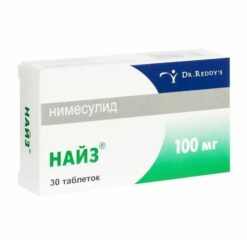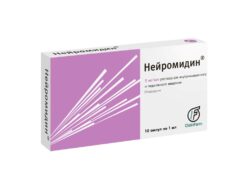-
×


-
×


Subtotal: €48.00




Subtotal: €48.00




Subtotal: €48.00
€1.00
Out of stock
(E-mail when Stock is available)
The drug for the treatment of alcohol addiction.
Nalmefen is an opioid system modulator with pronounced affinity for μ-, δ- and κ-receptors.
Reducing alcohol consumption in adult patients with alcohol dependence who are at high risk of alcohol abuse, in the absence of physical manifestations of withdrawal syndrome or the need for immediate detoxification.
Selincro is recommended to be used in combination with long-term psychosocial support aimed at maintaining treatment adherence and reducing alcohol consumption.
Selincro is prescribed after two weeks of observation of a patient with a continuing high risk of alcohol abuse.
A drug for the treatment of alcohol dependence.
Nalmefene is a modulator of the opioid system with pronounced affinity for μ-, δ- and κ-receptors.
Selincro is not intended to achieve immediate abstinence from alcohol. Reducing alcohol consumption is an intermediate goal on the path to complete abstinence.
Opioid use
In an emergency situation when a patient taking Selincro requires the administration of opioids, the doses of the latter required to achieve the desired effect may exceed the standard ones. Patients should be closely monitored for symptoms of opioid-induced respiratory depression and other adverse reactions.
If opioid administration is necessary to provide care to a patient in an emergency, dosages must be individualized. If excessively high doses of opioids are required, the patient should be carefully monitored.
Selincro should be temporarily discontinued 1 week before opioid use, such as during elective surgery.
A physician prescribing Selincro should advise the patient to inform health care providers of the time of last use of the drug in cases where the use of opioids becomes necessary.
Caution should be exercised when medications containing opioids (eg, antitussives and opioid analgesics) are used in patients already receiving Selincro therapy.
Nalmefene is contraindicated in patients currently taking opioid analgesics.
Concomitant diseases
Mental disorders
During clinical studies, adverse reactions from the psyche were reported (see section “Side effects”). If the patient experiences mental disorders that are not associated with the initiation of Selincro and/or they are not temporary, the physician should consider alternative causes of these symptoms and assess the need to continue therapy with Selincro.
Selincro has not been studied in patients with unstable mental illness. Selincro should be prescribed with caution to patients with concomitant mental illnesses in the decompensation phase, incl. patients diagnosed with major depressive disorder.
Seizure disorders
Experience with the drug in patients with a history of seizure disorders, including seizures that develop during alcohol withdrawal, is limited. Caution is recommended if Selincro is used to reduce alcohol consumption in this patient population.
Impaired kidney or liver function
Selincro is actively metabolized in the liver and is excreted primarily in the urine. For this reason, caution should be exercised when prescribing Selincro to patients with mild or moderate renal or hepatic impairment. Caution should be exercised when prescribing Selincro to patients with elevated ALT and AST levels (more than 3 times the upper limit of normal), because this category of patients was excluded during clinical studies.
Elderly patients (≥65 years)
Clinical data on the use of Selincro in alcohol-dependent patients aged 65 years and older are limited. Caution should be exercised when prescribing Selincro to patients aged 65 years and older.
Other
Caution should be exercised when using Selincro simultaneously with potent inhibitors of the UGT2B7 isoenzyme.
Lactose
Patients with rare hereditary problems such as galactose intolerance, lactase deficiency or glucose-galactose malabsorption should not use this drug.
Impact on the ability to drive vehicles and operate machinery
The effect of nalmefene on the ability to drive vehicles and operate machines has not been studied.
Selincro may cause unwanted reactions such as nausea, dizziness, insomnia and headache. Most of these reactions were mild to moderate in severity and were noted only at the beginning of treatment.
Patients taking Selincro are not recommended to drive vehicles or operate machinery until their individual response to the drug is determined.
Nalmefene
One tablet contains:
Active substance – nalmefene hydrochloride dihydrate 21.917 mg in terms of nalmefene hydrochloride 20.0 mg, in terms of nalmefene 18.06 mg;
Excipients – microcrystalline cellulose 61.4 mg,
lactose anhydrous 60.683 mg,
crospovidone (type A) 4.5 mg,
magnesium stearate 1.5 mg;
Film coating – Opadry OY-S-28849 white 4.5 mg (hypromellose (5 mPa.s), macrogol 400, titanium dioxide (E171)).
Hypersensitivity to nalmefene or any of the components of the drug; hereditary galactose intolerance, lactase deficiency or glucose-galactose malabsorption.
Use in patients currently taking opioid analgesics.
Current or recent opioid dependence.
Acute opioid withdrawal symptoms.
Suspicion of recent opioid use.
Severe liver failure (Child-Pugh classification).
Severe renal failure (estimated glomerular filtration rate (eGFR) <30 ml/min per 1.73 m2).
Alcohol withdrawal (including hallucinations, seizures and delirium tremens) in the recent past.
Children and adolescents (up to 18 years) (efficacy and safety of use have not been confirmed).
Pregnancy, breastfeeding period.
With caution:
Concomitant mental disorders in the decompensation phase (due to the lack of clinical data); history of seizure disorders, including seizures that develop during alcohol withdrawal; mild or moderate renal or liver failure, elevated ALT and AST levels (more than 3 times the upper limit of normal); simultaneous use of powerful inhibitors of the UGT2B7 isoenzyme for a long time; elderly patients (>65 years).
The most common adverse reactions in clinical studies were nausea, dizziness, insomnia and headaches.
Most of these reactions were mild or moderate, related to the start of treatment, and of short duration.
Confusion and, less commonly, hallucinations and dissociation have been reported in clinical studies.
Most of these reactions were mild or moderate, associated with the start of treatment, and short-term (hours to days).
Most adverse reactions disappear with continued treatment and do not recur with repeated use.
Alcoholic psychoses, alcohol withdrawal syndrome or concomitant mental illnesses were also observed; as a rule, they were short-term.
Frequency is defined as: very often (≥1/10), often (≥1/100 to
– Nutrition and metabolism
Common: Decreased appetite. Reducing body weight.
– From the mental side
Very common: Insomnia.
Common: Sleep disturbance, confusion, restlessness, decreased libido (including loss of libido).
Frequency unknown: Hallucinations (including auditory, tactile, visual and somatic hallucinations), dissociation.
– From the nervous system
Very common: Dizziness, headache.
Common: Drowsiness, tremor, impaired attention, paresthesia, hypoesthesia.
– From the cardiovascular system
Common: Tachycardia, palpitations.
– From the digestive system
Very common: Nausea.
Common: Vomiting, dry mouth.
– From the skin and subcutaneous tissue
Common: Hyperhidrosis.
– From the musculoskeletal system
Common: Muscle spasms.
– General disorders
Common: Fatigue, asthenia, malaise, unusual sensations.
In vivo drug interaction studies have not been conducted.
Based on in vitro studies, no clinically significant interactions are expected between nalmefene or its metabolites and concomitantly prescribed medicinal products that are primarily metabolized by CYP450 and UGT enzymes or membrane transporters.
Concomitant use with drugs that are strong inhibitors of the UGT2B7 enzyme (for example, diclofenac, fluconazole, medroxyprogesterone acetate, meclofenamic acid) can significantly increase the effect of nalmefene.
This is unlikely to be a problem with occasional use, but if concurrent long-term treatment with a potent UGT2B7 inhibitor is initiated, the potential for increased exposure to nalmefene cannot be excluded. On the other hand, coadministration of a UGT inducer (eg, dexamethasone, phenobarbital, rifampicin, omeprazole) may result in subtherapeutic plasma concentrations of nalmefene.
If Selincro is used concomitantly with opioid agonists (eg, some cough and cold drugs, some antidiarrheals, and opioid analgesics), the patient may not benefit from the opioid agonists.
There are no clinically significant pharmacokinetic interactions between nalmefene and alcohol. A slight deterioration in cognitive and psychomotor functions is possible after administration of nalmefene. However, the effect of nalmefene and alcohol in combination does not exceed the sum of the effects of each substance taken separately.
Concomitant use of alcohol and Selincro does not prevent alcohol intoxication.
In a study of patients diagnosed with pathological gambling, nalmefene was administered at doses up to 90 mg/day for 16 weeks. In a study of patients with interstitial cystitis, 20 patients took nalmefene 108 mg/day for more than 2 years.
A case of a single dose of ialmefene 450 mg has been reported, which was not accompanied by changes in blood pressure, heart rate, respiratory rate or body temperature.
In these cases, the safety profile of nalmefene was consistent with that described above in the “Side Effects” section, but observational experience is limited.
Treatment
In case of overdose, symptomatic therapy and monitoring of the patient’s condition are recommended.
H. Lundbeck A/O, Denmark
| Manufacturer | Х. Lundbeck A/O, Denmark |
|---|---|
| Medication form | pills |
| Brand | Х. Lundbeck A/O |
Buy Selincro, 18 mg 14 pcs. with delivery to USA, UK, Europe and over 120 other countries.